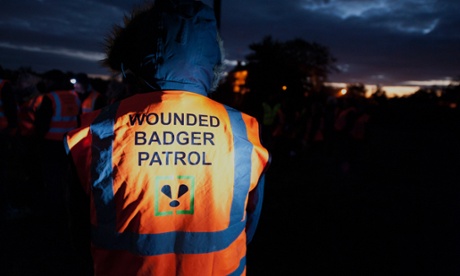
The controversial badger cull
in England is set to fail for the second year running, with shooters
far behind the required number of kills, according to Guardian sources. The six-week culls are due to end on Monday and environment secretary, Liz Truss, says the outcome will determine whether they are rolled out
across the country in an attempt to curb rising tuberculosis in cattle.
Over 26,000 TB-infected cattle were slaughtered in 2013.
But ministers have abolished independent expert analysis of the culls, a move being challenged by an ongoing legal battle. A leading badger expert said on Friday that the targets set for the latest culls were scientifically “rubbish”, meaning no conclusion would be able to be drawn from them. The most recent data obtained by the Guardian shows that, two-thirds of the way through the Gloucestershire cull, fewer than a third of the required badgers had been shot. A landmark 10-year trial showed that killing too few badgers actually increases TB in cattle as the disturbed badgers scatter.
In the other cull zone in Somerset, the Guardian understands the shooters are on track to meet the target set by the Department of Environment, Food and Rural Affairs (Defra). But Professor Rosie Woodroffe, a badger expert who worked on the 10-year trial, said: “The targets are all rubbish because they are based on rubbish data. In Somerset they set themselves an unbelievably easy target. It was not set in line with their aim – to kill at least 70% of badgers. They have completely thrown that out.”
Officials estimated the Somerset population by counting setts and multiplying by a fixed number, a method described as “very crude” by Prof Woodroffe. This estimate suggested the target should be between 316 and 1,776 badgers killed, with Defra choosing the lowest figure.
There is a 97.5% chance the cull will therefore fall short of the 70% mark, according to Prof Woodroffe. In Gloucestershire, the range was estimated as 391 to 1,292, with 615 being chosen as the target.
“Defra claim to take a precautionary approach to setting these targets. But killing too few badgers risks increasing cattle TB, quite the opposite of precautionary,” she said. “Furthermore, with the data that is being collected, it will be impossible to know how effective this year’s culls have been.”
Defra’s now-disbanded Independent Expert Panel (IEP) judged the 2013 culls to be neither effective or humane. “I wonder if the government no longer wants to know the answer to whether their ongoing pilot culls will deliver the required outcome,” said IEP member, Prof Tim Coulson at the University of Oxford, in June.
Read on...
But ministers have abolished independent expert analysis of the culls, a move being challenged by an ongoing legal battle. A leading badger expert said on Friday that the targets set for the latest culls were scientifically “rubbish”, meaning no conclusion would be able to be drawn from them. The most recent data obtained by the Guardian shows that, two-thirds of the way through the Gloucestershire cull, fewer than a third of the required badgers had been shot. A landmark 10-year trial showed that killing too few badgers actually increases TB in cattle as the disturbed badgers scatter.
In the other cull zone in Somerset, the Guardian understands the shooters are on track to meet the target set by the Department of Environment, Food and Rural Affairs (Defra). But Professor Rosie Woodroffe, a badger expert who worked on the 10-year trial, said: “The targets are all rubbish because they are based on rubbish data. In Somerset they set themselves an unbelievably easy target. It was not set in line with their aim – to kill at least 70% of badgers. They have completely thrown that out.”
Officials estimated the Somerset population by counting setts and multiplying by a fixed number, a method described as “very crude” by Prof Woodroffe. This estimate suggested the target should be between 316 and 1,776 badgers killed, with Defra choosing the lowest figure.
There is a 97.5% chance the cull will therefore fall short of the 70% mark, according to Prof Woodroffe. In Gloucestershire, the range was estimated as 391 to 1,292, with 615 being chosen as the target.
“Defra claim to take a precautionary approach to setting these targets. But killing too few badgers risks increasing cattle TB, quite the opposite of precautionary,” she said. “Furthermore, with the data that is being collected, it will be impossible to know how effective this year’s culls have been.”
Defra’s now-disbanded Independent Expert Panel (IEP) judged the 2013 culls to be neither effective or humane. “I wonder if the government no longer wants to know the answer to whether their ongoing pilot culls will deliver the required outcome,” said IEP member, Prof Tim Coulson at the University of Oxford, in June.
Read on...

No comments:
Post a Comment